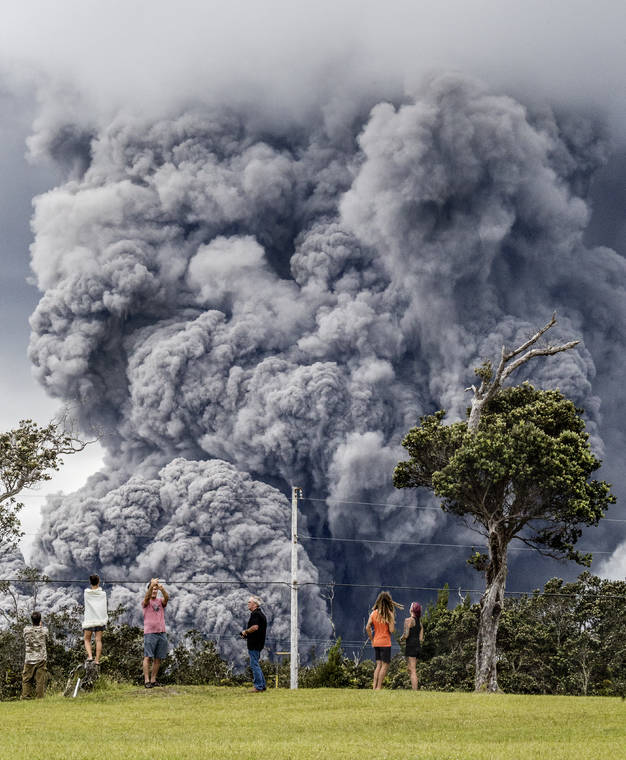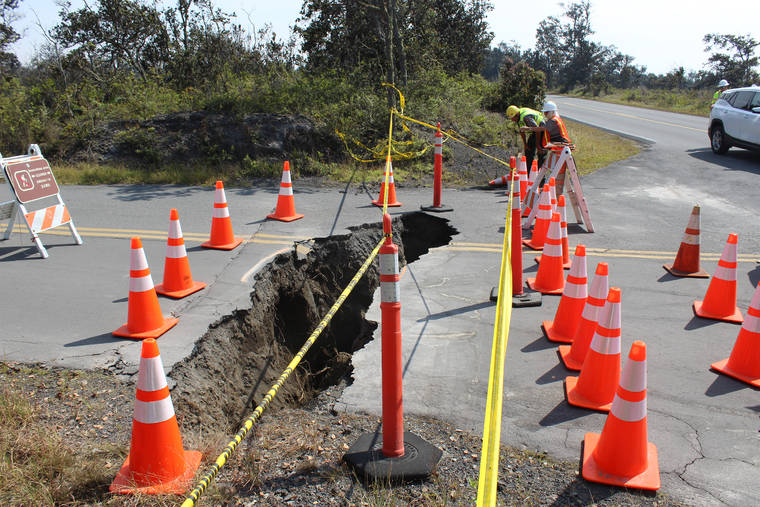One year ago, the earth split open and changed the landscape of Puna irrevocably.
But in Volcano, many of the lasting changes caused by the Kilauea eruption are within residents’ psyches.
At the eruption’s peak, hundreds of earthquakes were felt daily around the Kilauea caldera, ranging from minor tremors to greater shocks as parts of Halema‘uma‘u crater collapsed. While few residents in the area reported substantial physical damage to their properties after the eruption ended, that level of upheaval exacted a psychological toll.
“It was every single day,” said Janet Coney, Volcano resident and general manager of the Kilauea Lodge. “Everyone was on edge all the time.”
The first quakes of the eruption occurred a few days before the first breakout of lava in lower Puna on May 3, and the largest earthquake to strike the state in more than 40 years occurred the day after, when a 6.9 magnitude quake rocked Kilauea’s south flank.
“I was driving to (Kilauea Military Camp) when the earthquake hit,” said Ben Hayes, Volcano resident and director of interpretation for Hawaii Volcanoes National Park. “The car was shaking and I thought, ‘the road is not this bad.’ And then I saw all the trees shaking.”
However, Coney said that quake “felt like nothing” compared to a smaller quake that struck the next day closer to the summit: a 5.3 magnitude temblor that originated from a point just east of Pahala shook Volcano to its bones. Coney said the smaller quake shook glassware off shelves and made residents realize that “something big is happening.”
“It was unfathomable what would end up happening,” Coney said.
After the 6.9 earthquake, the national park shut down for most of a weekend but reopened shortly thereafter. Later that week, however, concerns grew that the receding lava lake at the crater would allow groundwater to seep into the magma shaft, causing a potentially dangerous steam explosion. In light of those fears, the park shut down again.
It would not reopen for 134 days.
“There were acute and present dangers in the park every day until the quakes stopped,” Hayes said.
Hayes said a geologist visiting the park during the closure said he wasn’t sure whether the park needed to be closed — until a “collapse/explosion event” occurred that day, which Hayes said the geologist called “terrifying.”
Throughout the closure, the park was subjected to semi-regular tremors caused by the subsidence of the crater floor as the lava lake receded. The tremors occurred on an almost daily basis, and although they were not felt far beyond Volcano, they registered near the park as having energy equivalent to magnitude 5.0 earthquakes or larger.
“It was a summer of very high stress,” said Hayes, who added that he resides not far from the crater itself. “I went to a wedding in June, and that was the first time I slept well in weeks.”
The stress caused by the endless quakes was compounded by the immediate impact on tourism to the area. Suddenly, with the park closed, once-thriving businesses became mere skeletons of their former selves.
“I’d say we lost something like 40 percent of our revenues,” said Del Bothof, owner of Volcano Winery. “It all happened so fast, there was no way to adjust.”
Bothof, who lives in Hilo, said he would worry each day about the state of his business, although none of the quakes did much more than rattle the winery’s vats and break a few tasting glasses. It was not, he concluded, “a very fun time.”
Over time, however, the earthquakes became a fact of life. Ira Ono, resident and owner of Volcano Garden Arts, said his pet cat was terrified of the first quakes and couldn’t be found for hours after each quake ended.
“Eventually, he wouldn’t even bother,” Ono said. “The quake would start, and he would lift his head up for a bit and then lay back down.
“And then it stopped, just like a dream.”
The end of seismic activity coincided with a sudden drop in lava production at the lower East Rift Zone. Where before it appeared as though fissure 8 would spew lava forever, its flow dropped to a mere trickle, and the intervals between collapse events at the summit became longer and longer.
But the end of the eruption was not the end of the area’s woes.
“We had a ruined park,” Hayes said. The constant tremors had irreparably damaged the park’s water system and rendered vast swaths of infrastructure unusable. Hayes said some trails resembled Swiss cheese, with all their new potholes.
Nonetheless, the park made a commitment to open by Sept. 22, Public Lands Day, and, thanks to what Hayes called a “Herculean effort,” successfully did so. More than 2,000 guests visited the park on its reopening day to witness a Halema‘uma‘u crater that had more than doubled in size since the start of the eruption.
Business owners throughout Volcano agreed that the reopening of the park has invigorated the town’s industry, but many remain cautious. With no lava in the summit crater, one of the chief draws to the park is gone, with no indication of a return.
“It will never go back to where it was … or not anytime soon, anyway,” Bothof said.
“It’s not going to readjust back without that glow from the crater.”
Ono said the eruption forced the business community to come together to find a way to sell Volcano as a tourist destination without relying on the lava.
In the midst of the eruption, Ono founded Experience Volcano, a tourist advocacy group originally intended to counter eruption-related concerns surrounding the area. Since the end of the eruption, the group has worked to reposition Volcano as a quiet artist collective surrounded by peaceful nature.
And while that impression seems to be working — Ono said rentals have picked up this spring, while Bothof said business is about at the level of early 2017 — the wounds of the eruption run deep.
“Every time there’s another quake, I start to wonder,” Coney said, referring to a 5.3-magnitude Hualalai quake that occurred in April. “Your mind just starts racing: ‘is it starting up again?’”
Email Michael Brestovansky at mbrestovansky@hawaiitribune-herald.com.


